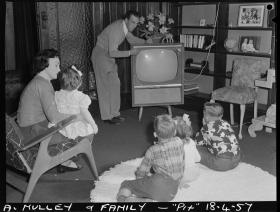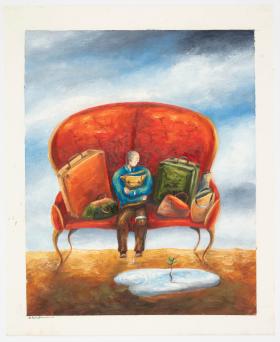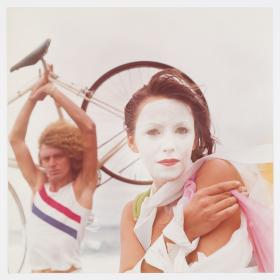Anyone who climbed Uluru on the morning of 24 March 1972 — long before the ethical issues around doing so entered mainstream national conversation — might have stumbled across a curious sight: a middle-aged man, balding and bushybearded, sitting cross-legged with his eyes closed, meditating and perhaps chanting odd incantations. And under the influence of Queensland-grown psilocybin mushrooms.
This man was Allen Ginsberg. In this altered state atop a sacred place, his mind turned to his family. ‘Thought of you so sending love right here from the top,’ he wrote to his father from Uluru, ‘my face covered with little flies buzzing.’
The poet was midway through a reading tour of Australia — his one and only visit to the country — along with fellow Beat icon Lawrence Ferlinghetti and the Russian poet Andrei Voznesensky. Ginsberg had come to Uluru between readings in Adelaide, Melbourne, Sydney and Brisbane, as part of a month-long stay that sent ripples through the Australian literary and arts community. The visit would have a transformative impact on Ginsberg’s own poetics, politics and understanding of the world.
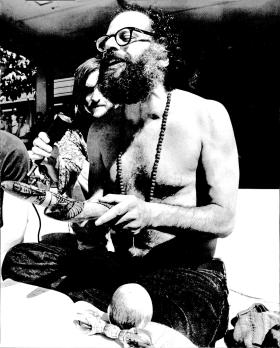
Ginsberg was 45 years old when he arrived in Australia that autumn, 16 years after the publication of ‘Howl’ (with its infamous trial), and 11 years since the other long poem that brought him cultural fame, ‘Kaddish’. The previous year, 1971, had been a pivotal one even for him, a man whose life sprawled and embraced so many causes and aesthetics across all corners of the globe.
In the second half of that year, he travelled to Calcutta, India, and spent time in camps for refugees escaping genocide in Bangladesh. That trip, funded by Keith Richards of The Rolling Stones, had a profound effect upon him and yielded one of his most famous poems, ‘September on Jessore Road’. Later that year he stayed with John Lennon and Yoko Ono at a residence in New York state. As 1971 turned to 1972, he was working on an album with Bob Dylan that was pitched to be released on the famous Apple label, set up by The Beatles (it didn’t happen).
So, it’s fair to say that this trip to Australia early in 1972 occurred at a point not only when Ginsberg’s prominence and associations with the great and the good in pop culture were at their zenith, but also as a spiritual adjustment was taking place within him. He would take the Refuge and Bodhisattva Vows later in 1972. Ginsberg’s tour of Australia came amid an eventful period of personal development and political awakening.
‘Ginsberg had wanted to visit Australia for at least ten years prior to his actual visit,’ says David Wills, Beat Generation scholar and author of the book World Citizen: Allen Ginsberg as Traveller. ‘Whilst on his famous round-the- world trip that included his long stay in India [in 1962], he wrote about wanting to continue on to Southeast Asia and down to Australia, but for various reasons he could not. In 1968 he also spoke about wanting to get back on the road and head to Australia, but again this fell through.’
The tour was not without incident. Ginsberg, Ferlinghetti and Ferlinghetti’s nine-year-old son Lorenzo left San Francisco on 27 February 1972, stopping over in Hawaii and Fiji before reaching Adelaide, where they were joined by Voznesensky. The three poets were on the bill at Adelaide Writers’ Week, part of the Adelaide Festival. Ginsberg’s main reading took place at Adelaide Town Hall, but he held other more informal events across the city, including at Port Adelaide Town Hall, outdoors at Flinders University, and even in his own hotel room, entertaining followers until the small hours.

They took turns performing poems and songs, with Ginsberg reading his own work or that of William Blake, and the songmen telling stories. This went on for hours and included improvised poems, using songsticks to keep time.
The poet and artist Richard Tipping, who was also on the bill at Writers’ Week, remembers this event as ‘completely extraordinary, a first time, nothing translated – an urgent didgeridoo, clap sticks, half a dozen dancers holding gum leaves.’
Writer and critic Murray Bramwell was also in attendance. ‘Ginsberg celebrated the Aboriginal performers, giving them centre-stage and joining them with awkward, disinhibited Brooklyn Jewish dance moves of his own,’ he says. ‘The audience was thrilled by the spontaneity and the cultural and emotional unity of the event. This was classic Ginsberg — using his celebrity to bring together people and cultures in spite of the systemic racism in Australia at the time — and still now.’
Ginsberg’s ability to bring people together was mentioned in reviews, with one write-up noting that it was ‘a sad reflection that it took an American poet to bring Australia’s major arts festival face to face with its responsibility to promote and present what is our only authentic national art form’. Ginsberg himself wrote in a letter that the Indigenous community had ‘been shut out of the festival … so I gave them an hour of my reading.’
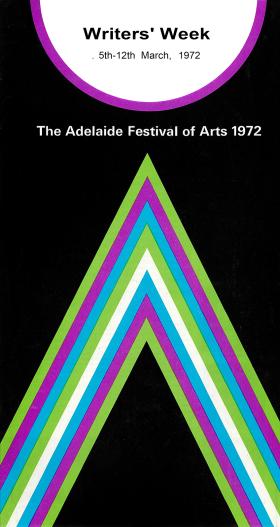
There was also excitement at the Sydney reading, which took place at the Conservatorium of Music – an incident involving the enfant terrible artist Brett Whiteley that has passed into the city’s folklore. According to Whiteley biographer Ashleigh Wilson’s account, a shirtless Whiteley, drunk on whisky, started making a commotion during Ferlinghetti’s reading, which he thought was ‘boring’. Whiteley, who attended with his wife, Wendy, and friends, started shouting, waving his arms and ‘raving on incoherently’ until he was removed, and then, following a further scuffle in the foyer, arrested. The poet Pam Brown was in attendance that night and remembers that the ‘mad painter’ even bit a policeman’s ear. Ginsberg, meanwhile, was fairly placid about the incident, and ended up having dinner with Whiteley prior to leaving Sydney for Arnhem Land.
The Brisbane reading occurred in the final days of Ginsberg’s time in Australia (exact dates have been difficult to pin down). Held at the Student Union at the University of Queensland, it is perhaps the most interesting large, ticketed reading he gave, with, arguably, the most ‘underground’ or bohemian feel. Ginsberg and Voznesensky made a spontaneous decision to stop off in Brisbane, having been invited by the counterculture magazine HARPO. Perhaps because this performance was less formal than the others, there was, it seems, no controversy or confrontation. One attendee, Peter Marquis-Kyle, recalls that ‘lighted joints were handed out freely to the audience at the door’. The Aboriginal pastor and activist Don Brady was at this reading and performed on didgeridoo, with dancers who gave an ‘exhibition of Corroboree’, according to a HARPO report of the event. Ginsberg donated $100 from door takings to Brady.
That same HARPO review also gives an insight into how Ginsberg was treated by the Australian mainstream media. The review mocks the inane questions of a TV reporter at a press event — ‘How many poems have you written, Mr Ginsberg?’ — and describes how a newspaper photographer asked the poet to wear a white feather in his hair because ‘he didn’t suit their conception of what a “beat” poet looks like’. The resulting interview in the Courier Mail, the HARPO author writes, ‘seems as if it was done for five minutes over the phone by a child of ten with limited vocabulary’.
Ginsberg had a loose ‘set list’ that remained fairly consistent during his Australian tour. He read several poems written while he was here, including some composed on the day of performance, as at the Sydney reading. Aboriginal elements — clap sticks, didgeridoos — were also incorporated on numerous occasions. Ginsberg accompanied himself on harmonium at times for what he defined as ‘blues ragas’ that also featured sitar, guitar and dobro. He sang William Blake’s ‘Nurse’s Song’ from Songs of Innocence to his own melody, as well as other Blake works, in most, perhaps all, readings. Ginsberg tried and failed to give up smoking while travelling in Australia and regularly performed a song or mantra titled ‘Put Down Your Cigarette Rag’. Many recollections of Ginsberg’s Australian readings highlight this particular piece, which lambasted the tobacco industry and warned of smoking’s health perils.
Relatively recent works such as ‘September at Jessore Road’ and ‘Wales Visitation’ certainly made appearances. When it came to his most famous poem, ‘Howl’, however, Ginsberg was reluctant. Tipping remembers Ginsberg announcing at Adelaide Town Hall, ‘I wrote “Howl” a long time ago, and don’t read it anymore, but I’ve been asked to read it tonight.’ Ginsberg could also be riled by certain requests, with one attendee at the Melbourne reading stating that Ginsberg was ‘visibly irritated and refused’ when asked to repeat a performance of the Blake poem. Another element of Ginsberg’s participation in these readings was as occasional translator for Voznesensky’s Russian poems.
Beyond these high-profile performances, Ginsberg made excursions into the country’s more remote areas, often to visit Indigenous communities. As well as the visit to Uluru, ‘a holy rock mountain with ancient petroglyphs’, as he wrote in another letter, he also visited Arnhem Land, where he spent time with Wandjuk Marika, the Indigenous leader, artist and musician. At Yirrkala, Ginsberg observed a traditional funeral with burial rites that lasted days and exchanged songs with Marika (even singing in Pitjantjatjara). Experiences like this were important to Ginsberg and his writing; two lectures he gave in 1976, titled ‘Spontaneous Poetics’, drew on what he learned on this trip among Indigenous Australians, with poetic breath, rhythm and communal participation being central themes.
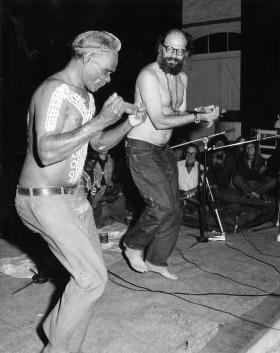
Some of the most interesting anecdotes from people who remember the Ginsberg tour of Australia are of personal interactions. For example, Murray Bramwell, a young PhD student at the time, rang Ginsberg’s Adelaide hotel in the hope of meeting or interviewing him. The hotel took a message, and Bramwell resigned himself to nothing coming of it.
‘A day or so later, one of the people in the group house where we were living called out to me and said there was someone called Allen Ginsberg on the phone, he wants to speak to you,’ Bramwell recalls. ‘I was amazed, and impressed by his gracious matter-of-factness. We talked for about ten minutes, mostly about his enthusiasm for these blues ragas and his plans for recording with Dylan.’
Tipping, 22 at the time, was tasked with driving Ginsberg from his hotel to the reading at Flinders University, and remembers discussing the poet’s concept of ‘Moloch’ from ‘Howl’ in relation to the Adelaide cityscape. In the same city, the poet Robert Adamson was among those whom Ginsberg entertained in his hotel room until late; he was advised by Ginsberg to contact the American poet Robert Duncan, sparking a trans-Pacific friendship between Adamson and Duncan that lasted decades. Pam Brown’s boyfriend sat next to Ginsberg on a flight from Sydney to Darwin, and the poet signed a copy of Hamlet for him. It was perhaps because of this geniality and accessibility among Australians that another Beat poet, Gary Snyder, was moved to tell Ginsberg after his own visit here in 1981, that he ‘heard many recollections of you in Australia’.
Intriguingly, Ginsberg’s letters home from Australia suggest he even considered moving here to live, though it’s hard to believe he entertained this idea too seriously. He was put off by the country’s racism, which he certainly came across in Adelaide, and most likely elsewhere. In a letter to Snyder, he noted the relatively cheap price of land, but wrote, ‘If there weren’t such tough white karma I’d sell m’lot and emigrate and rusticate by the southern oceanside.’ Ginsberg planned to return for the 1998 Adelaide Festival, but died in April 1997.
Another unknown is the identity of a young musician with whom Ginsberg had a brief fling in Adelaide. ‘Beautiful 20-year-old dobro player who stayed over and slept with me and gave me a yoga book,’ he wrote to fellow poet Gregory Corso. Who this musician was, and what happened to him, is a mystery. But he would have a story to tell.
Barnaby Smith is an arts writer, poet and musician who lives in the Blue Mountains.
This story appears in Openbook autumn 2022.


